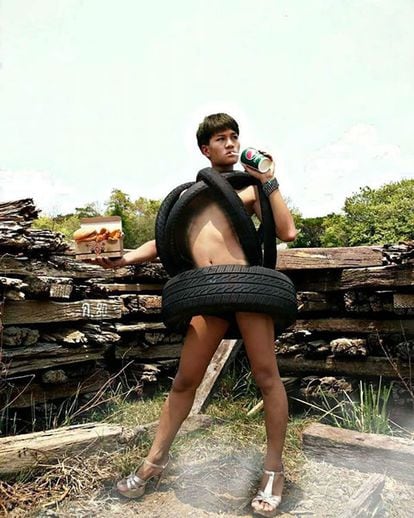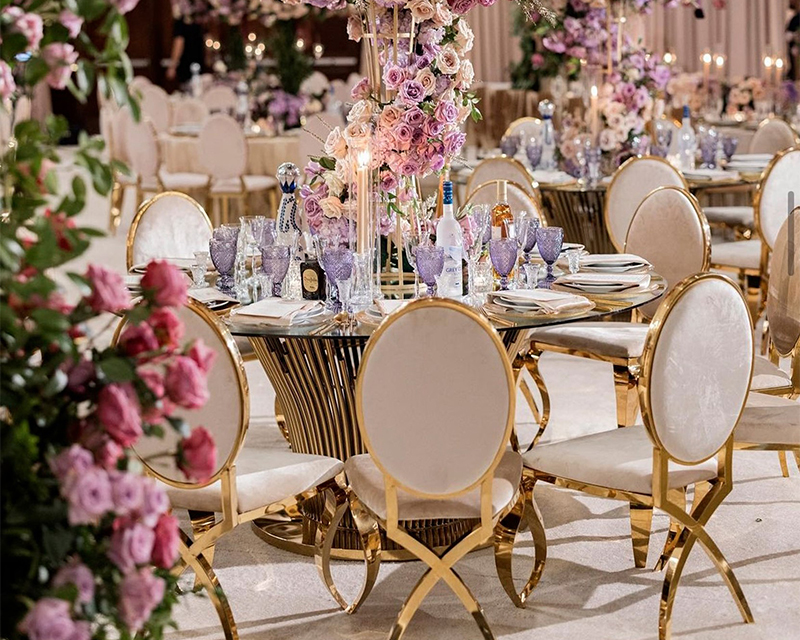Shaheel Shermont Flair is 24 decades previous, and he needs to be a comedic actor. On his social media, the place he showcases his talent for comedy through video clips/reels, he describes himself as a “public figure” and “artist.” On June 20, he shared his latest witty concept on line: a trend display parody. “Fashion reveals be like this,” he declared (alongside the emoji of a facial area crying with laughter). Then, barefoot and dressed in a T-shirt and activity shorts, he begun going for walks like Linda, Naomi, or Christy by means of what appears like the yard of his residence. Each and every trip shown a model established with all types of knickknacks, junk, utensils and house furnishings. In an unintentionally Rickowensian moment (or not), he even made use of his minimal sister, Riharika, who was accessorized and off to the side, as a enhance. On TikTok, in which he has been showing up as @shermont22 for a minimal a lot more than a yr, the small online video has racked up more than 5 million sights and counting. He proceeds to get followers as very well he has nearly 350,000 appropriate now and 13 million or so “likes.” Viewers continue to keep asking him for more. At preferred ask for, he uploaded his most current online video a handful of several hours back. It is the ninth installment of a viral saga that, in fact, is not so ironic and hilarious.
By today’s expectations, Shermont is presently a star in conditions of fame and glory. In a the latest story on his Instagram profile (@shermont_22, which has significantly much less followers, while a single assumes that his viewership there will at some point mature), he confessed to possessing googled his title and was in disbelief about how much-achieving his general performance was. “I’m in the information!” He was stunned and posted screenshots from distinct electronic media, particularly from Southeast Asian outlets. On Twitter, he is becoming hailed as the week’s hero for producing entertaining of, mocking, and deriding that silly and progressively absurd matter: style (of course).
The exact issue occurred just two months in the past, when a movie on Douyin (a social network) went viral on its Western counterpart, TikTok, supplying increase to the switch-your-grandmother-into-an-international-supermodel obstacle. In the online video, a venerable elderly Chinese female was dressed as the personification of Balenciaga, Gucci and Prada by a very little boy (presumably her grandson) with what he experienced on hand in his yurt, which include rooster. The success of the challenge—images accomplished in the style of luxurious promoting campaigns with brand name logos superimposed on them—tell us that we are all Demna Gvasalia, Alessandro Michele, or the tandem Miuccia-Raf Simons, or at minimum we can be.

For a extensive time, men and women have complained regularly about how poor fashion is, now extra than at any time. Not only does trend pollute the planet and exploit its employees, but it also mocks consumers. Are these designers insane? No, they are just pulling our leg with so a lot aesthetic arbitrariness/ugliness/stupidity. It is only reasonable, then, to return the favor in jaw-droppingly amusing techniques. In actuality, trolling the style industry—like Shermont and the Chinese grandmothers (there are rather a handful of of them)—may be evidence of a specific social disgust with its three-ring circus and its trainers, illusionists, and clowns, whose extravagances are recognized as nonsense and, even worse, insults or in close proximity to-insults. Vetements’s DHL uniform. Virgil Abloh’s Ikea bag. JW Anderson’s broken-skateboard-encrusted sweater. Balenciaga’s shredded sneakers. All of Balenciaga, the model inevitably referred to in opinions on the younger comedian’s reels. There are additional than a couple of comments that also praise Shermont’s attitude and stylish model’s trot they inquire to see his fashion clearly show in Paris and Milan previously. And then there are all those who endeavor to be funnier and much more sarcastic and ironic than the movie by itself, which is regular on Twitter. But none of the commenters have taken issue—or even tried using to consider issue—with the video’s deeper premise.
Shaheel Shermont Flair is a Fijian of Indian descent his ancestors were Indian girmtyas who went to British-colonized Fiji in the mid-nineteenth century as slave labor. He is also homosexual. “Welcome the queen to Instagram,” he urged in April 2021, when he debuted on the social media internet site. In November, he posted that “[m]y sexuality isn’t the problem, your bigotry is.” In April of this calendar year, he returned to the fray: “There are individuals who dislike me for staying various and not living by society’s requirements, but deep down they want they had my courage.” Right before his phenomenal manner present, he was by now accomplishing “low cosplay” of Indian females by making use of waste—toilet paper for the sari, a bottle cap for a nath on the nose, and a tea bag for the maang tikka on the forehead, for example—to make an Indian bride’s trousseau in the playful post, “Getting completely ready for my lover.” In a different, he straps on two water-stuffed balloons as swaying breasts underneath his T-shirt. “The matters I do for TikTok,” he wrote. In fact, Shermont has built comedy his route to escape bullying and discrimination (prejudice is double in his circumstance) and turned his social media accounts into a highway to heaven. Just like Apichet Madaew Atirattana did again in his working day.

Besides for its glamorous intent, every little thing about Shermont’s catwalk recalls that of the so-known as Thai Dovima. In 2016, in advance of Tik Tok’s one-monitor mind took in excess of, a teenager from the rice-expanding location of Isaan—one of Thailand’s poorest areas—astonished the earth by turning every day objects, twigs, and trash into magnificent outfits. He filmed himself modeling all those outfits at distinctive areas in his village his grandmother acted as a styling assistant. Facebook and Instagram went wild in excess of what was termed the “break down of obstacles concerning gender identity, trend and recycling.” At the time, Madaew (a nom de guerre) described it this way: “I want people today to see that hideous matters that really don’t in shape in can be remodeled into anything lovely. And that dressing nicely is not about funds.” Just a several months later, Asia’s Upcoming Leading Product, the South Asian version of the U.S. talent clearly show, termed him to be a visitor designer throughout the program’s fourth year. The adhering to year, Time journal place him on its checklist of new generational leaders. His case in point unfold. Before long, new stars created their appearance: Suchanatda Kaewsanga, a fellow Thai who is openly trans, and the Chinese Lu Kaigang, whose choices for vogue demonstrates in his village—located in Guangxi province—unironically provided dresses designed of rubbish can lids and previous air-conditioner baggage.
Right here, we have a response from the poor and marginalized to fashion’s world-wide effects as a mass phenomenon ascribed to the culture of leisure/leisure. It is a practice that resonates with the button-down politics of Patrick Kelly, the initial African American designer to join the ranks of the Parisian prepared-to-dress in trade association in the mid-1980s the apparel actions of the swenkas (workers of Zulu origin) and skhothanes (publish-apartheid impression-obsessed youth) in Johannesburg and the young Ghanaians who exploit the town-sized textile dumps encompassing the cash, Accra, as sources for their creativity. The narratives of the designers who establish the industry’s existing path, amplified as never prior to by electronic media, also present that it is certainly attainable to gown as stylishly as Balenciaga, Gucci or Prada without the need of breaking the financial institution. That’s why TikTok’s Chinese supermodel grandmothers mirror aspiration and not scorn they are proof that vogue has one thing for every person, even the most socially disadvantaged (just one just cannot pass up the happy hashtag that normally accompanies them, #chinastreetstyle). That is why Apichet Madaew Atirattana, Suchanatda Kaewsanga and Li Kaigang have produced occupations as creators, bloggers or influencers with hundreds of thousands of followers. They’ve appear so considerably, propelled by the dreamy gas that the publications in village hair salons and satellite Television give. “It’s incredibly straightforward to blame trend for all the issues it generates, but I’d like to imagine it is also able of assisting folks in a lot of techniques, in constructive techniques,” suggests Minh-Ha T. Pham, a professor of media research at Pratt Institute in New York and the creator of Asians Don Dresses on the World wide web (2016), an essay about the dynamics of race, gender and course among the youthful Asians who have found a way to convey their identification by means of fashion, and in the system pushed the process to lastly acknowledge them as a socioeconomic and cultural force. Shaheel Shermont Aptitude laughs, but he does manner exhibits because he also understands what manner can do for his ambition to develop into an actor.




